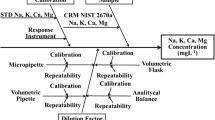Abstract
Three reference materials, at relatively low, middle, and high concentrations, were developed for analysis of the mass fractions of electrolytes (K, Ca, Na, Mg, Cl, and Li) in human serum. The reference materials were prepared by adding high purity chloride salts to normal human serum. The concentration range of the three levels is within ±20% of normal human serum. It was shown that 14 units with duplicate analysis is enough to demonstrate the homogeneity of these candidate reference materials. The statistical results also showed no significant trends in both short-term stability test for 1 week at 40 °C and long-term stability test for 14 months. The certification methods of the six elements include isotope dilution inductively coupled plasma mass spectrometry (ID-ICP-MS), inductively coupled plasma optical emission spectroscopy (ICP-OES), atomic absorption spectroscopy (AAS), ion chromatography (IC), and ion-selective electrode (ISE). The certification methods were validated by international comparisons among a number of national metrology institutes (NMIs). The combined relative standard uncertainties of the property values were estimated by considering the uncertainties of the analytical methods, homogeneity, and stability. The range of the expanded uncertainties of all the elements is from 2.2% to 3.9%. The certified reference materials (CRMs) are primarily intended for use in the calibration and validation of procedures in clinical analysis for the determination of electrolytes in human serum or plasma.

Certified reference materials for K, Ca, Mg, Na, Cl and Li in human serum (GBW09124-09126)





Similar content being viewed by others
References
Tietz N, Pruden E, Anderson OS. Electrolytes, blood, gas, and acid–base balance. In: Tietz NW, editor. Fundamentals of clinical chemistry. 3rd ed. Philadelphia: Saunders; 1987.
Barbagallo RP, Boley N, Holcombe G, Merson S, Mussell C, Pritchard C, et al. Production and certification of four frozen human serum certified reference materials containing creatinine and electrolytes. Ann Clin Biochem. 2008;45:160–6.
Cali JP, Bowers GN, Moore L, Young DS. A reference method for the determination of total calcium in serum. Clin Chem. 1973;19:1209–13.
Külpmann WR, Reuschke D, Büttner J, Paschen K. A candidate reference method for the determination of magnesium in serum. J Clin Chem Biochem. 1989;27:33–9.
Thienpont LM, Van NJE, Stöckl D. Ion chromatography as reference method for serum cations. J Chromatogr A. 1997;789:557–68.
Directive 98/79/EC of the European Parliament and of the Council of 27 October 1998 on in vitro diagnostic medical devices. Off J Eur Communities. L331:1–37.
International Organization for Standardization. ISO/IEC 17025: general requirements for the competence of testing and calibration laboratories. 2nd ed. Geneva: International Organization for Standardization; 2005.
International Organization for Standardization. ISO Guide 34: general requirements for the competence of reference material producers. Geneva: International Organization for Standardization; 2000.
International Organization for Standardization. ISO Guide 35: reference materials-general and statistical principles for certification. Geneva: International Organization for Standardization; 2006.
Li B, Hu JY, Zhao MT. The performance and application on the collision/reaction cell ICP-MS. J Chin Mass Spectrom Soc. 2010;31:1–11.
Murphy KE, Long SE, Rearick MS, Ertas ÖS. The accurate determination of potassium and calcium using isotope dilution inductively coupled plasma mass spectrometry. J Anal At Spectrom. 2002;17:469–77.
Feng LX, Ma LD, Wang J, Lu H. Certification of reference materials for Cd, Cr, Hg and Pb in polypropylene. Anal Bioanal Chem. 2010;396:3051–7.
General Administration of Quality Supervision, Inspection and Quarantine of China. JJG 1005-2009: verification regulation for electrolyte analyzer. Beijing: General Administration of Quality Supervision, Inspection and Quarantine of China; 2009.
Sargent M, Harrington C, Harte R. Guidelines for achieving high accuracy in isotope dilution mass spectrometry (IDMS). Cambridge: Royal Society of Chemistry; 2002.
Yu LL, Davis WC, Ordonez YN, Long SE. Fast and accurate determination of K, Ca, and Mg in human serum by sector field ICP-MS. Anal Bioanal Chem. 2013;405:8761–8.
Berglundl M, Wieser ME. Isotopic compositions of the elements 2009 (IUPAC Technical Report). Pure Appl Chem. 2011;83:397–410.
EURACHEM. Quantifying uncertainty in analytical measurement. Teddington: LGC; 1995.
Barbosa JTP, Santos CMM, Bispo LDS, Lyra FH, David JM. Bromine, chlorine, and iodine determination in soybean and its products by ICP-MS after digestion using microwave-induced combustion. Food Anal Methods. 2013;6:1065–70.
Date AR, Stuart ME. Application of inductively coupled plasma mass spectrometry to the simultaneous determination of chlorine, bromine and iodine in the National Bureau of Standards Standard Reference Material 1648 Urban Particulate. J Anal At Spectrom. 1988;3:659–65.
Bettinelli M, Spezia S, Minoia C, Ronchi A. Determination of chlorine, fluorine, bromine, and iodine in coals with ICP-MS and IC. Atom Spectrosc. 2002;23:105–10.
Balcone-Biossard H, Michel A, Villemant B. Simultaneous determination of fluorine, chlorine, bromine and iodine in six geochemical reference materials using pyrohydrolysis, ion chromatography and inductively coupled plasma-mass spectrometry. Geostand Geoanal Res. 2010;33:477–85.
Goenage-Infante H. Final report for CCQM-K107: total elements and selenomethionine in human serum. Metrologia. 2016;53(1A):08008.
International Organization for Standardization. Evaluation of measurement data—guide to the expression of uncertainty in measurement. Geneva: ISO; 2008.
Acknowledgements
The authors gratefully acknowledge the financial support from the National Basic Research Priorities Program (No. 2011FY130100), National Natural Science Foundation (No. 11475163), and NIM Fundamental Research Program (No. AKY1403).
Author information
Authors and Affiliations
Corresponding author
Ethics declarations
The authors declare that they have no conflict of interest.
Informed consent was obtained from all individual participants included in the study. All procedures performed in studies involving human participants were in accordance with the ethical standards of the Chinese PLA Center for Disease Control & Prevention and with the 1964 Declaration of Helsinki and its later amendments or comparable ethical standards.
This article does not contain any studies with animals performed by any of the authors.
Rights and permissions
About this article
Cite this article
Feng, L., Wang, J., Cui, Y. et al. Development of certified reference materials for electrolytes in human serum (GBW09124-09126). Anal Bioanal Chem 409, 3483–3493 (2017). https://doi.org/10.1007/s00216-017-0287-9
Received:
Revised:
Accepted:
Published:
Issue Date:
DOI: https://doi.org/10.1007/s00216-017-0287-9



